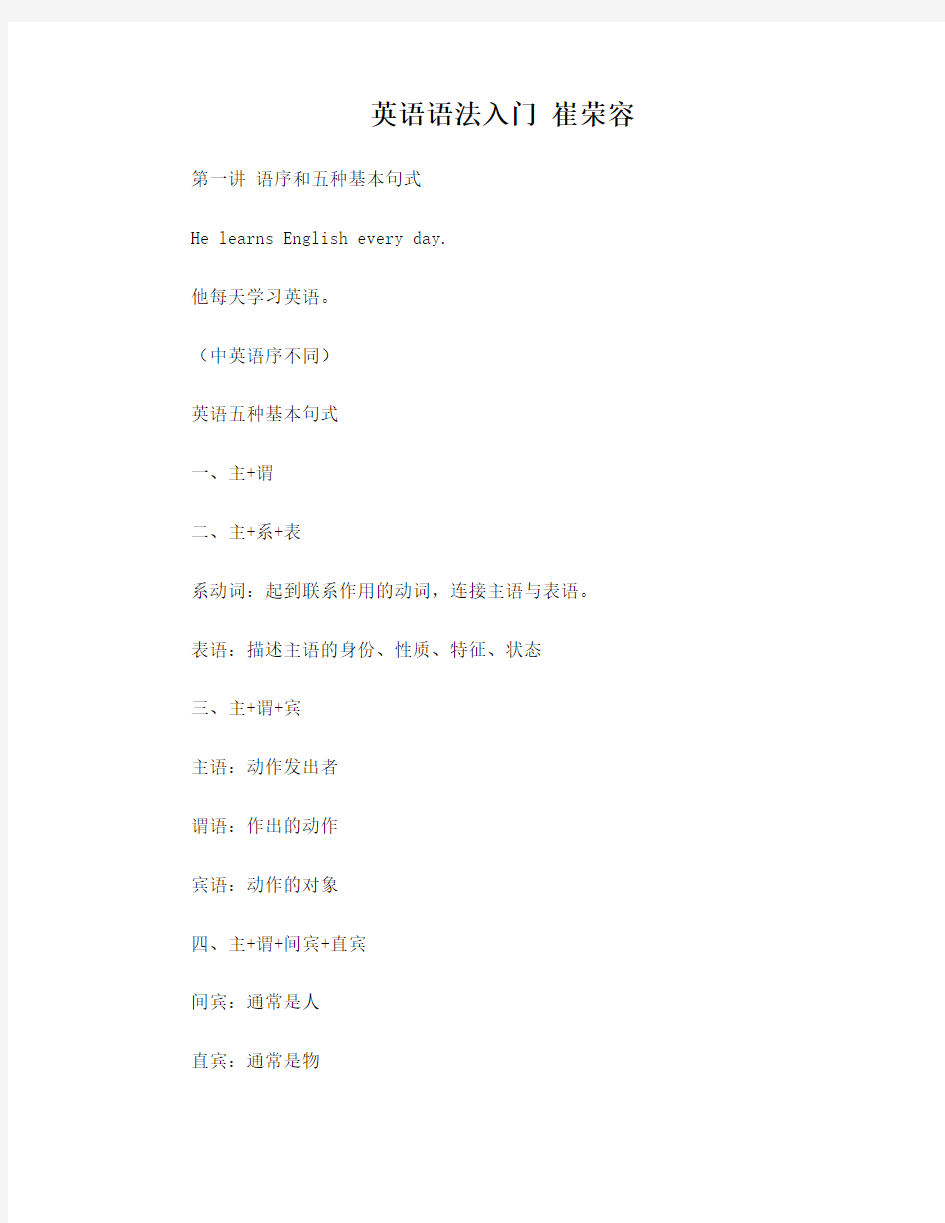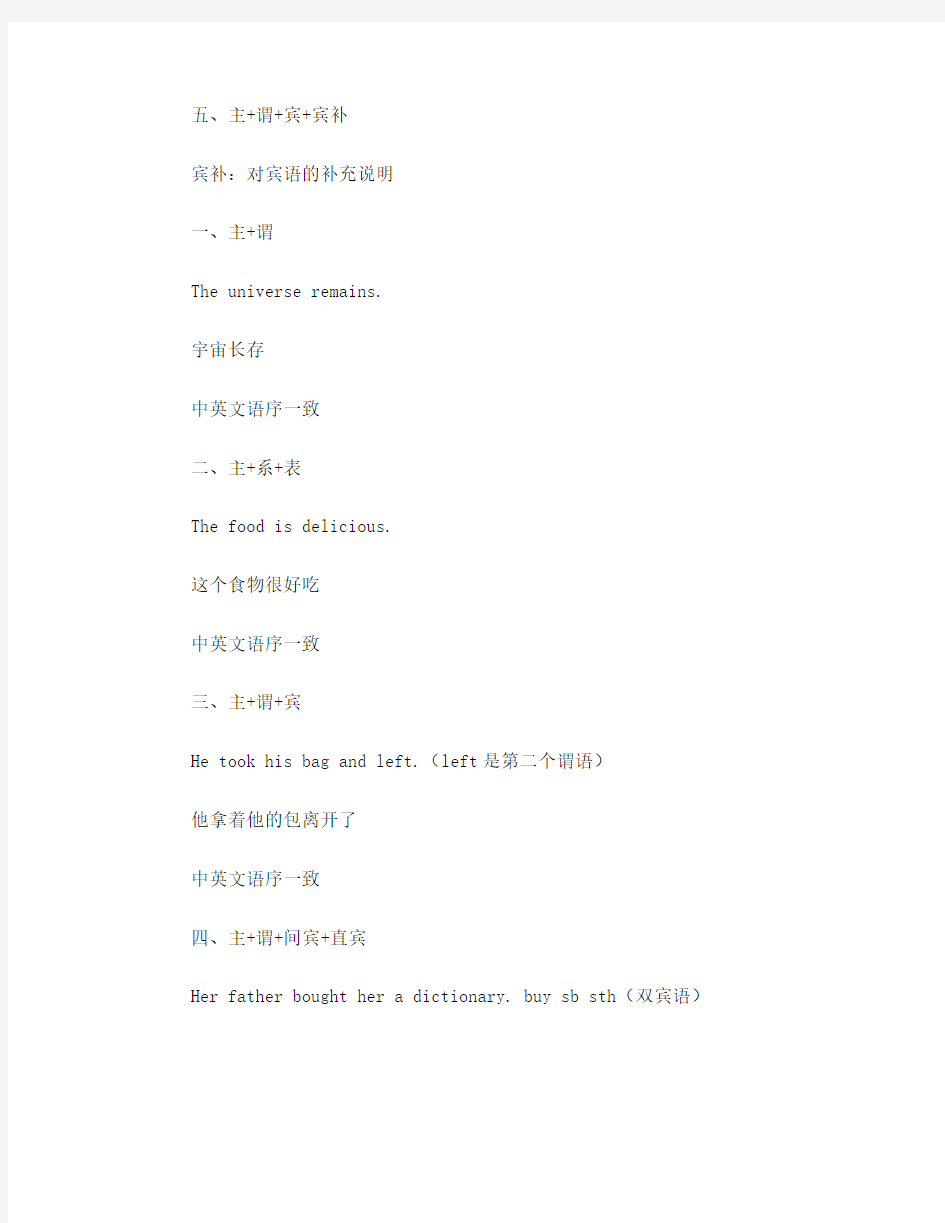

英语语法入门崔荣容第一讲语序和五种基本句式
He learns English every day.
他每天学习英语。
(中英语序不同)
英语五种基本句式
一、主+谓
二、主+系+表
系动词:起到联系作用的动词,连接主语与表语。
表语:描述主语的身份、性质、特征、状态
三、主+谓+宾
主语:动作发出者
谓语:作出的动作
宾语:动作的对象
四、主+谓+间宾+直宾
间宾:通常是人
直宾:通常是物
五、主+谓+宾+宾补
宾补:对宾语的补充说明
一、主+谓
The universe remains.
宇宙长存
中英文语序一致
二、主+系+表
The food is delicious.
这个食物很好吃
中英文语序一致
三、主+谓+宾
He took his bag and left.(left是第二个谓语)
他拿着他的包离开了
中英文语序一致
四、主+谓+间宾+直宾
Her father bought her a dictionary. buy sb sth(双宾语)
她爸爸给她买了一本词典(her与 a dictionary,两个宾语,一个是人、一个是物)
中英文语序一致
五、主+谓+宾+宾补
We made him our monitor.
我们选他当班长
(him与 our monitor,都是指同一个人,our monitor是对him的补充说明)
中英文语序一致
Nothing is impossible to a willing heart!
有志者事竟成!
第二讲 be动词的形式和用法
一、be动词的形式:be、am、is、are、was、were、being 、been
1、 The man is back.
2、 They are back.
3、 He was back.
4、 They were back.
5、 They have been back.
6、I’ll be back.
上述“back”是副词,构成主系表结构。
二、be动词的用法:起到联系前后的作用(一般翻译为“是”,或无实意而不作翻译),多用于主系表结构。后面接名词、形容词、地点副词或短语作补足语成分。
1、 The man is a teacher. a teacher是名词
2、Mary’s new dress es are colorful. colorful是形容词
3、 My mother was in the kitchen. in the kitchen是地点副词。
4、 I am 20. 数词也可做表语
5、It’s me. 代词也可做表语
三、be动词的练习
1、他们是老师
They are teachers.
2、他曾是一名老师
He was a teacher before.
3、他已经当了3年的老师
He has been a teacher for 3 years.
第三讲 be动词的否定/提问/回答
一、be动词的否定
在am、is、are、was、were后面加not
缩略式am not,isn’t,aren’t,wasn’t,weren’t
1、The man isn’t back.
2、 I am not back.
3、They aren’t back.
4、He wasn’t back.
5、They weren’t back.
二、使用be动词提问和回答
Is he a teacher?
Yes,he is./No,he isn’t.
Are you a teacher?
Yes,I am./No,I am not.
Were they teachers?
Yes,they were./No,they weren’t.
三、be动词的练习:
1、他是医生吗?
Is he a doctor?
不,他不是
No,he isn’t.
2、他们昨天在教室吗?
Were they in the classroom yesterday? Yes,they were./No,they weren’t.
3、他们昨天不在教室
They weren’t in the classroom yesterday.第四讲代词的主格和宾格
主格代词:I he she it you we they
1、I am a teacher.
2、He is a teacher.
3、You are teachers.
宾格代词:me him her it you us them
1、 He likes me.
2、 We like her.
3、 I like them.
练习
1、我喜欢它
I like it.
2、他们认识他
They know him.
第五讲名词性/形容词性物主代词
形容词性物主代词:(后接名词)
单数形式:my your his/her/its one’s
复数形式:our your their
1、 This is my book.
2、 We love our motherland.
3、 Those are your socks.
名词性物主代词:
单数形式:mine yours his/hers/its one’s 复数形式:ours yours theirs
1、 The book is ours.
2、 The apple is hers.
练习
1、我的老师是中国人
My teacher is Chinese.
2、这个电脑是他们的
This computer is theirs.
3、我们的书在书架上
第六讲反身代词
单数myself yourself himself herself itself
复数ourselves yourselves themselves
反身代词的用法:(指某人自己,通常是主语的“自己”)
1、 Please help yourself to some fish.请随便吃些鱼吧
yourself在动词help后作宾语;2、Weenjoyedourselveslast;ourselves 在动词enjoyed后作宾语;3、Thethingitselfisnotimp;反身代词itself在名词Thething后作同;练习;1、Takegoodcareof(yoursel;2、Shegainedcontrolof(her;第七讲实意动词的
yourself在动词help后作宾语。
2、 We enjoyed ourselves last night.我们昨晚玩得很开心
ourselves在动词enjoyed后作宾语。
3、 The thing itself is not important.这件事本身不重要
反身代词itself在名词The thing后作同位语,起到解释、说明名词的作用。
练习
1、 Take good care of(yourself )照顾好??
2、 She gained control of (herself ) 控制住了??
第七讲实意动词的特征
实意动词come go read watch play fly
1、He comes from Shenyang.
实意动词comes作谓语,后接介词短语from Shenyang作宾语动词come 有一般现在时“单三”的变化
2、She is reading story books.
实意动词reading作谓语,后接动词story books作宾语动词read有现在进行时的变化
3、They went to America yesterday.
动词go 有一般过去时“went”的变化
4、We have watched the game for three times.
动词watch 有现在完成时“watched”的变化
现在完成时:动作已经发生或对现在造成影响
5、My mother will fly back to China next month. 一般将来时:will+动词原形
总结:实意动词有时态与数量(三单)上的变化
练习:
1、他昨天来上海了
He came to ShangHai yesterday.
2、我们正在写作业
We are writing homework.
3、他们读这本书已经读3遍了
They have read this book three times.
第八讲实意动词的否定/提问/回答
(一般现在时与一般过去时)
使用助动词进行否定
在助动词do does did后面加not
do not/don’t
does not/doesn’t
did not/didn’t
例句:
1.I don’t go to school by bus.
2.She doesn’t watch TV everyd ay.
3.They didn’t swim last night.
使用助动词进行提问
1. He often plays golf.
Does he often play golf?
Yes,he does./No,he doesn’t.
2. They go to school by bus.
Do they go to school by bus?
Yes they do./No,they don’t.
3. Sam had breakfast yesterday. Did Sam have breakfast yesterday? Yes,he did./No,he didn’t.
练习:
1. 他每天都学英语吗?
Does he learn English everyday?
是的,他每天都学英语
Yes,he does.
2. Tom昨天没吃早饭
Tom didn’t have breakfast yesterday.
第九讲使用疑问词进行提问和回答(1)(一般现在时与一般过去时)
使用疑问词进行提问
when,where,who,what,how
时间、地点、人物、干什么、怎样
例句 He bought three books yesterday.
1 2 3
1. Who bought three books yesterday?
对主语提问,原语序不变
2. What did he buy yesterday?
对宾语提问时,将助动词提前,并还原动词。
3. When did he buy three books?
对状语提问时,将助动词提前,并还原动词。
They wanted to go to ShangHai by air.
1 2 3
1. Who wanted to go to ShangHai by air?
2. Where did they want to go by air?
3. How did they want to go to ShangHai?
第十讲使用疑问词进行提问和回答(2)
使用疑问词进行提问
how long, how far, how often, why
多长时间,多远,多长时间一次,为什么
1. They have been in China for three years.
How long have they been in China? 对时间状语提问 2.It is about 4000 kilometers from Beijing to Xi’an. How far is it from Beijing to Xi’an?
3.They come to visit me once a week.
How often do they come to visit me?
4. She came late, because she missed the bus.
Why did she come late?
练习:
1. 他们学汉语多长时间了?
How long have they learned Chinese?
2. 你多长时间看一次电影?
How often do you watch movies?
3. 你的家离学校多远?
How far is it from your house to your school?
第十一讲名词
代表事物的词,包括具体和抽象的事物
名词分两类:
1.可数名词:是指数得过来的概念。如apple\pencil\student 可数名词有单数和复数之分
apple-apples
pencil-pencils
tomato-tomatoes
2.不可数名词:无法计算的数量或抽象概念。如
salt\coffee\water\(history\love抽象)
不可数名词无复数,只用单数表示
salt-salt
coffee-coffee
water-water
3.可数名词变复数规则:
(1)一般末尾加后缀-s,friend-friends
(2)以s\z\x\ch\sh结尾的词,在该词末尾加后缀-es,bus-buses (3)辅音字母+y结尾的名词,将y改变为i,再加es,
candy-candies (除a e i o u以外的字母为辅音
字母)
(4)以-o结尾的名词,如果不是外来词或缩写,就加-es.
tomato-tomatoes,hippo-hippos缩写
(从非英语国家引进的词汇为外来词,如madam是
从法国引进的外来词)
3、可数名词前可加a(an)或量词,有复数变化
以元音开头的名词前加an,以辅音开头的名词前加a,表示一个。 apple——an apple——apples
——a box of apples 量词
Tomato——a tomato——tomatoes
——a bag of tomatoes 量词
4、不可数名词前不可加a(an),没有复数,但前面可以加量词。
Coffee——a cup of coffee
练习:
He bought me (a box of chocolate )一盒巧克力
(abike)一辆自行车;第十二讲代词:指示代词和不定代词;指示代词(特指):标识人或事物的代词,用来代替前;常用的:this\these\that\thos;不定代词(泛指):指代不确定的人或事物;常用的:one\theother\some\an;练习;
1.(These)teachersarefrom;这些教师都是中国来的;
2.Iknow(nothing)
(a bike) 一辆自行车
第十二讲代词:指示代词和不定代词
指示代词(特指):标识人或事物的代词,用来代替前面已提到的名词。
常用的:this\these\that\those This is his book. Those apples were his.
不定代词(泛指):指代不确定的人或事物。
常用的:one\the other\some\any\something\nothing 例: No one knows where he is. 没人知道他在哪儿 Some of the boys want to go to Shanghai,but the others want to go to Xi’an. 一些男孩想去上海,其他人想去西安 Each of the students has got a book. 每个学生都有一本书。
练习
1.(These)teachers are from China.
这些教师都是中国来的。
2.I know(nothing )about this person.
我对这个人一无所知
3.I have (something)to tell you.
我有事要告诉你
第十三讲形容词
1、形容词通常形容人或事物的状态、性质、大小等,通常用在名词前,be
动词后
beautiful-beautiful girl
The girl is beautiful.
2、The+形容词=复数名词(表示一类),作主语时,后面的动词
使用复数的相应格式。
old-the old 老的—老年人(一类人、复数名词) young-the young 年轻的—年轻人(一类人、复数名词) The old need more care than the young. The old是复数名词,后面的动词need不能用三单的格式。
3、练习:
(1)She is a ( good )student.
她是一个好学生。
(2)This bike is ( expensive )
这辆自行车很贵
(3)( The rich )sometimes complain their empty life. 富人有时抱
怨他们空虚的生活
第十四讲副词
1、副词可以修饰动词、形容词、其它副词以及其他结构。一般表程度。
He runs fast.
She is very beautiful. very修饰形容词beautiful They work very hard.
副词的位置
(1)根据情况,放在助动词之后,实意动词之前或之后
(2)形容词之前,其它副词之前或之后
(3)多个助动词时,副词一般放在第一个助动词后 He speaks very fast.
fast在实意动词speak之后,在其它副词very之后。 They have already left. already在助动词have后 They have already been repaired. already在第一个助动词have后
2、常用的频度副词
(always\usually\often\sometimes\never??)的位置通常放在实意动词前面,be动词后面,助动词和实意动词之间。 They always come early. Sam often writes homework at 7:00.
练习:
1、Please write the word( slowly)(慢慢地)
2、They (sometimes)come here. (有时)
3、The tree is ( very )tall.(非常)
第十五讲不定量表达法(1)
不确定数量的表达法,用不确定的数量词来限定名词 Some any most every all
1. some,any都表示“一些”,后面接可数名词复数、不可数名
词单数。some主要用于肯定句,希望得到肯定回答时,也可用在疑问句中。any主要用在否定和疑问句中。
I’d been expecting some letters the whole morning,but there weren’t any for me.
2. most作形容词时表示“大部分的”,后面接复数名词 Most people here are from China.
3. every表示“每一个、所有”,后面接单数名词。 Every one likes the film.
4. all表示“所有”,后面接可数名词复数、不可数名词单数。 All the cars are parked in the parking lot. All the coffee is served on time.
练习:
1. Some boys went camping yesterday.(一些)
2. All the children like to play football.(所有的)
3. Most teachers want to work here.(大多数)
第十六讲不定量表达法(2)
1. both表示“两者都”,可作形容词、代词和副词,either是“两者之一”,neither是“两者都不”。 Both his eyes were severely burned. There are trees on either side of the street. Neither answer is correct.
2. many修饰可数名词,表示“许多”;much修饰不可数名词,表示“许多”。a lot of(lots of)、plenty of均可修饰可数与不可数名词。
many books much water
a lot of/lots of books/water
练习: